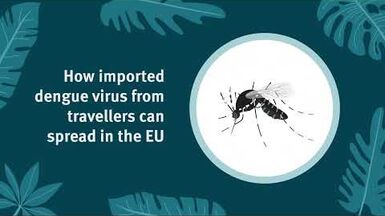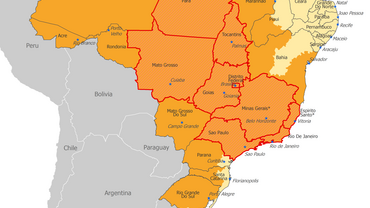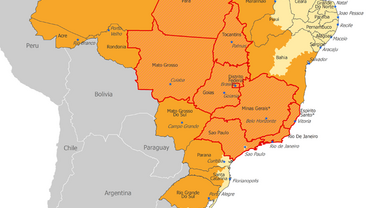Epidemiological update: Yellow fever outbreak in Brazil, 12 May 2017
Yellow fever is a mosquito-borne viral infection present in some tropical areas of Africa and South America. On 6 January 2017, Brazil reported an outbreak of yellow fever that started in December 2016 and is still ongoing. Bolivia, Colombia, Ecuador, Peru and Suriname have also reported cases of yellow fever in 2017.
Weekly summary
Between 27 April and 4 May 2017, Brazil has reported 14 additional confirmed cases in the states of Espírito Santo (9) and Minas Gerais (5), and has discarded 164 suspected cases.
Epidemiological summary
Brazil:
Between 6 January and 4 May 2017, Brazil has reported 1 392 cases of yellow fever (663 suspected and 729 confirmed), including 294 deaths (45 suspected and 249 confirmed). The case-fatality rate is 21.1% overall and 34.2% among confirmed cases.
States reporting suspected and confirmed autochthonous cases:
- Minas Gerais has reported 708 cases (224 suspected and 484 confirmed), including 180 deaths (16 suspected and 164 confirmed).
- Espírito Santo has reported 518 cases (306 suspected and 212 confirmed), including 94 deaths (23 suspected and 71 confirmed).
- São Paulo has reported 54 cases (37 suspected and 17 confirmed), including seven confirmed deaths.
- Rio de Janeiro has reported 23 cases (12 suspected and 11 confirmed), including four deaths (one suspected and three confirmed).
- Pará has reported 16 cases (12 suspected and four confirmed), including four confirmed deaths.
- Tocantins has reported four cases (three suspected and one confirmed).
States reporting suspected autochthonous cases:
Ten states have reported 69 suspected cases: Goiás (25, including 2 fatal), Paraná (16, including 1 fatal), Bahia (6), Rondônia (6), Distrito Federal (4, including 2 fatal), Rio Grande do Sul (4), Amapá (2), Maranhão (2), Mato Grosso do Sul (2) and Santa Catarina (2).
On 11 May, media reported the first confirmed case of yellow fever in the state of Amazonas, but no official confirmation has been found as of 12 May.
Other countries in South America:
From the beginning of 2017 to 8 May, five other countries have reported suspected and/or confirmed cases of yellow fever: Peru (14), Colombia (2), Bolivia (1), Ecuador (1) and Suriname (1).
Sources: Brazil MoH | PAHO | WHO vaccination recommendations
ECDC assessment
The ongoing outbreak should be carefully monitored, as the establishment of an urban cycle of yellow fever would have the potential to quickly affect a large number of people. EU/EEA citizens who travel to, or live in, areas where there is evidence of yellow fever virus transmission should check their vaccination status and obtain medical advice about being vaccinated against yellow fever.
In Europe, Aedes aegypti, the primary vector of yellow fever in urban settings, is present in Madeira. Recent studies have shown that Aedes albopictus can potentially transmit the yellow fever virus. However, the risk of the virus being introduced into local competent vector populations in the EU through viraemic travellers from Brazil is considered to be very low, as the current weather conditions in Europe are not favourable for vector activity.
Actions
ECDC closely monitors this event in collaboration with the World Health Organization. ECDC published its updated rapid risk assessment on 14 April 2017. ECDC is also producing epidemiological updates and a map for travel advice.
Related content
Read more
Yellow fever - Annual Epidemiological Report 2016 [2014 data]
In 2014, no cases of yellow fever were reported in EU/EEA countries.
Yellow fever among travellers returning from South America, March 2017
This risk assessment is triggered by the increase in the number of yellow fever cases among EU travellers with exposure in South America since August 2016 and assesses the risk of contracting yellow fever for travellers to South America.






